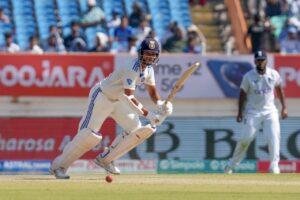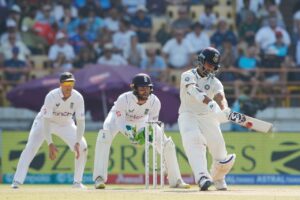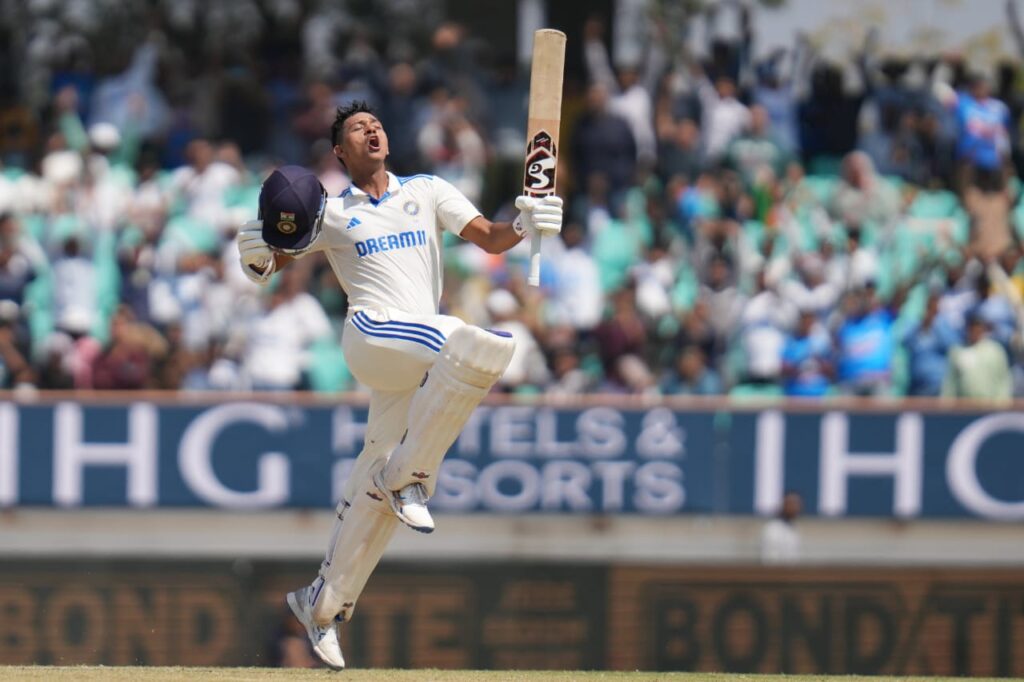
Yashasvi Jaiswal’s unbeaten 214 in the third Test not only propelled India to a resounding victory but also marked his consecutive double centuries in the series against England. This remarkable innings played a pivotal role as India clinched a convincing 2-1 lead in the ICC World Test Championship series. The tourists, set an imposing target of 557, succumbed to the Indian bowling attack and were dismissed for a mere 122 in Rajkot. With this win, India surges to second place in the WTC standings as they continue their march towards a third consecutive final berth.
Playing his 22nd first class game, Jaiswal recorded his 12th ton (50s: 4). He averages over 73 in the format. Decoding Jaiswal’s overall performance after seven Tests, his run tally stands at an impressive 861 runs. All these runs have been accumulated within the current WTC cycle, propelling Jaiswal to the summit of the leading run-scorer list, surpassing the likes of Usman Khwaja who trails behind with 855 runs. The youngster’s ability to convert centuries into daddy hundreds reached unprecedented heights as he became the first Indian to achieve three consecutive Test centuries of 150 or more.
At the age of 22 years and 52 days, Jaiswal secured his place as the third youngest player to score a double century in the second innings of a Test match, a remarkable achievement placing him alongside cricketing icons like George Headley and Sunil Gavaskar. Furthermore, he joined an elite club by scoring two double centuries in a series, a feat accomplished only by Vinoo Mankad and Virat Kohli in Indian cricket history. His ability to capitalise on good starts and convert them into monumental scores showcased his maturity beyond years.
For the Latest Sports News: Click Here

The left-hander’s fearless approach to batting has been highlighted by his six-hitting pedigree – an astonishing 22 sixes in the series – surpassing Rohit Sharma’s 19 against South Africa at home in 2019.
The sheer audacity of Jaiswal’s 12 sixes in a single Test innings equalled the record set by Wasim Akram in 1996. This remarkable exhibition of power hitting demonstrated his capacity to dominate and dismantle even the most accomplished bowling attacks, even though the current English bowling unit lacks a bit of experience minus James Anderson.
Even against Anderson, it was a completely different game. Jaiswal became only the second batter to hit the experienced pacer for three sixes in an over in Tests. The left-hander elegantly stooped low, executing a sweeping motion to dispatch a low full toss over deep square leg for a six, igniting the onslaught. Following this, Jaiswal’s acrobatic jump out of the crease met a full and wide delivery, which he skillfully carved over deep extra cover for the second six. The rhythm disrupted Anderson’s composure, leading to an innocuous length delivery that was effortlessly dispatched over the bowler’s head for the third six in a mesmerising over. This sequence not only showcased Jaiswal’s prowess but left an indelible mark on the ebb and flow of the game.

Jaiswal’s series aggregate of 545 runs not only surpassed Sourav Ganguly’s previous record but also set a new benchmark for the most runs by an Indian left-hander in a Test series at home. This extraordinary run-scoring spree solidifies his position as a prolific run-scorer for India in such a nascent career.
As a team, India have smashed 48 sixes in the ongoing series, the most any team has hit in a Test series. India beat the record they themselves set against South Africa in 2019 (47 sixes). 28 of those 48 sixes came in the Rajkot Test alone, the most by any team in a single Test match. Talk about Bazball?
Jaiswal’s innings in Rajkot was not just a display of cricketing talent; it was a record-breaking spectacle that will be remembered as a defining moment in the history of Indian Test cricket. However, he’ll know that the job is not done with the Ranchi Test set to commence on February 23.
Also Read: After the Brickbats, it’s time Rohit and Dravid got the Bouquets




